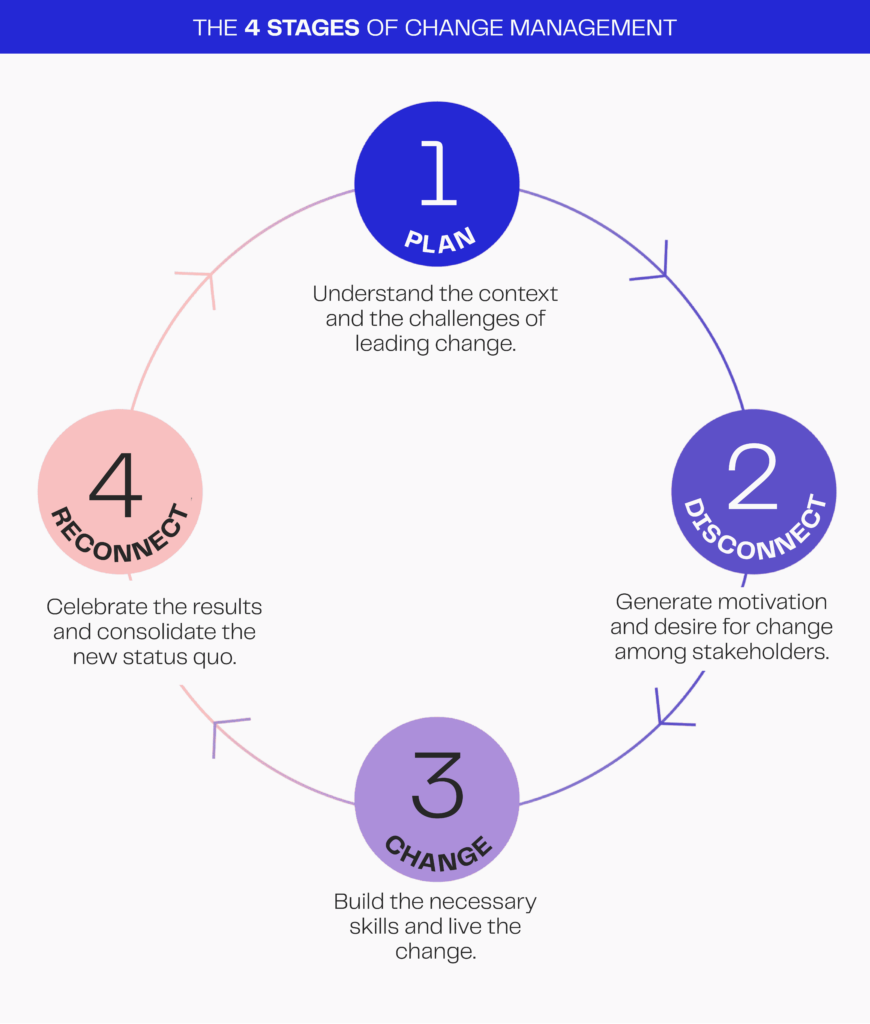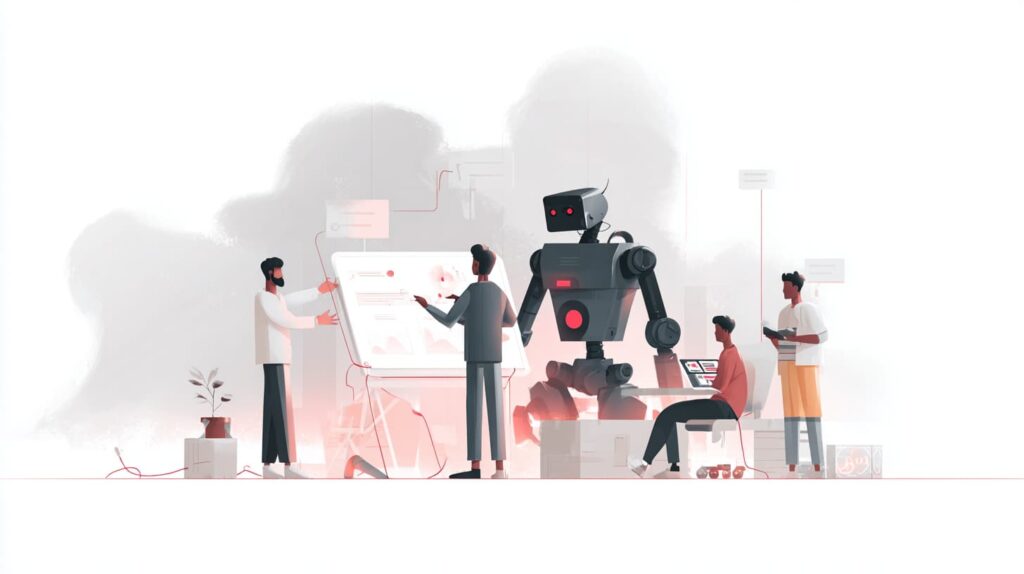By EloInsights
- The speed of technological and social change requires organizations to draw up a disciplined transformation strategy.
- Change management then appears as a process catalyst, dictating a continuous and cyclical rhythm of evolution.
- The article explains how to overcome barriers, addresses the pitfalls that leadership must avoid and points out ways to incorporate transformation into the DNA of the business.
In a world that seems to be spinning faster and faster, people and organizations are changing at an equally rapid pace. While strategic planning used to take five or more years to come to fruition, today this cycle has been considerably reduced. It’s common to see a company considered to be a platform for innovation – for example, a leader in the delivery segment – change its strategy half a dozen times in two years.
Change management (CM) then appears as a catalyst for transformations, shortening the distance between what we are today and what we want or plan to be. It establishes processes that accelerate the change of the status quo and the adoption of a vision of the future in a continuous and cyclical rhythm of evolution.
The term BANI (Brittle, Anxious, Nonlinear, Incomprehensible) is used by the American anthropologist Jamais Cascio to frame today’s world, which operates in increasing complexity. This classification has gained even more strength with the Covid-19 pandemic, which has disrupted working models and changed our relationships and interactions rapidly and suddenly.
At the same time, new generations are arriving on the market and driving a real renewal of the corporate environment. The challenge of meeting the different expectations of a workforce that is increasingly diverse, driven by purpose and more centered on people and their experiences – even more so when daily coexistence is hybrid or remote.
“Today, variables change so much and so fast that, without the ability to unfreeze the status quo, to open up to the future and to the transformation that is happening all the time, you are faced with a ceiling for the organization’s potential”, says Isabela Correia, manager at EloGroup.
Bureaucracy, resistance or unpreparedness to get rid of old models can have an impact on the very survival of the business. The first step to overcoming these obstacles is to prepare for a route, in the sense of increasing the organization’s capacity and openness to making a change. We can then look at Kurt Lewin’s model – which involves the phases of unfreezing, changing and refreezing – in a new light.
In a new reading, in addition to unfreezing perceptions, empowering stakeholders to experience change and refreezing new implementations, we add and emphasize a first phase: planning and preparing for change. Also, we see the refreezing stage more as a consolidation of new points of view. This ensures that the desired future model becomes the starting point for the next transformation, giving rhythm to the evolutionary cycles of change.
It is crucial to make processes, structures and mindset flexible and ingrained enough for the cycles of change to be short and constant. The steps of this journey also involve implementing a continuous paradigm of unfreezing and reshaping patterns to consolidate innovative approaches in line with the desired vision of the future.
No effective transformation can take place without specific goals. It is also important to know which problems will be solved and to define end points. Change management bridges the gap between the current model and the expected result, established in that first planning stage, by defining clear success metrics.
Digital makes it easier for organizations to connect with the outside world to contextualize and define objectives and which changes make sense, avoiding following fads that consume the team’s time, energy and effort without generating value for the business.
The 4 stages of change management
Change management contributes to the success of organizational transformations, ensuring a smoother implementation for those involved and allowing for a greater and faster capture of value. Among the main advantages are:
- Reduction of barriers and resistance to implementation;
- Agility in implementing the change; and
- Assimilation of the change by the impacted groups and enhancement of the results and aims initially envisioned as the future vision.
The Change Management process can be divided into four major stages:

1. Planning
The goal is to prepare the team and the organization to begin building the change. The preparation considers the specificity of the client’s context, such as structure, internal processes, challenges, and, most importantly, the desired results from the process. This stage generates value through:
- Mapping stakeholders and groups affected by the change;
- Defining clear metrics that will attest to the success of the change;
- Identifying possible risks to the success of the change; and
- Planning the proper timing of implementation and actions to execute it.
To achieve this, it is necessary to:
- Conduct an organizational readiness assessment, understanding the company’s openness and preparation for undergoing the change journey;
- Develop sponsorship, involving sponsors with knowledge and influence to accelerate adherence;
- Mobilize and prepare the change management team, providing the necessary knowledge and tools to understand the context and enhance the impacts of the changes to be made; and
- Define the change management strategy considering the challenges, context, and audience of each action.

2. Unfreezing
In a second phase, the goal is to “unfreeze” the current model and bring evidence to those involved that “what got us here won’t get us there,” as stated by author Marshall Goldsmith. It is the beginning of contact with stakeholders impacted by the transformation, seeking awareness, clarity, and incentives for the desire for change, exploring, on both organizational and individual levels, the reasons and benefits associated with it. This stage adds value by:
- Reducing barriers to change by communicating the benefits;
- Creating space for co-creation among the involved stakeholders; and
- Planning events and communication products about the changes in advance, according to the stakeholders’ profiles.
The key elements of this stage are:
- Coalition Network: Keeping or developing a network of allies for communicating the changes, who will serve as a direct channel to the impacted parties for disseminating the transformations and identifying potential pain points and resistances. It is important to ensure representation of areas, profiles, and positions within these groups.
- Impact Metrics: The success criteria function as a method for setting goals, considering the main objective and key results that attest to achieving this goal.
- Communication Strategies and Actions: Defining events and communication products considering the audience’s maturity in their contact with the change and adjusting key factors, such as the tone of communication and the depth of information, to promote transparency without causing anxiety.

3. Change
In this stage, the aim is to equip stakeholders with the knowledge and skills necessary to receive and experience the change according to the actions defined in the earlier stage. It is also to support any doubts, insecurities, and potential conflicts arising from the implementation. Consideration is given to the culture, power relations, context, and readiness of the audience for the new model. This stage adds value by:
- Providing the necessary information for executing the new model;
- Training for adherence to the new status quo of the change;
- Greater assertiveness in training techniques and communication strategies suitable for the target audience; and
- Minimizing negative feedback and resistance through close monitoring of the stakeholders.
The key elements of this stage are:
- Training and Reskilling: Structuring robust training and knowledge paths that clearly address the change topics. A comparative focus on before and after, clarifying new roles, processes, and all necessary information for executing the new status quo.
- Knowledge Pills: Creating materials to disseminate information about the change in a concise and practical manner, easy to share and with references for further exploration of the subject.
- FAQ: Developing and maintaining a document with the most often asked questions about the change, which is informative, easy to understand, situational, and easily accessible.
- Performance Monitoring: Developing an assessment of the absorption of concepts and execution of the new status quo through assessments with stakeholders – administering questionnaires, pulse surveys, interviews, checklists, etc.

4. Consolidation
In the final stage, which Lewin calls refreezing, the goal is to consolidate the changes made and ensure the maintenance of the new status quo. Here, it is possible to evaluate and measure whether the change was successful through success criteria, and thus share and celebrate the positive results of the new process. This stage adds value by:
- Data-driven actions, making the approach more specific and with well-defined objectives;
- Ensuring a clear end to the implementation cycle and the beginning of the continuous improvement cycle of the new process or new management model; and
- Celebration and fulfillment by stakeholders for taking part in the change cycle and experiencing its benefits.
The key elements of this stage are:
- Deactivation Plan for the Previous Model: Developing a plan with activities and deadlines to deactivate the old process and ease the transition to the new one. The aim is to establish migration milestones with clear metrics.
- Recognition and Reinforcement Strategies: Organizing events and meetings to recognize the stakeholders involved and celebrate the results.
- Management Rituals: Defining periodic agendas to set goals, monitor targets, and distribute activities.

Burning the Bridges with the Past
Internal processes and policies, hierarchical relationships, routines, governance, rituals, and forms of communication can all be levers or barriers to a transformation. When we understand the impacts of change on each of these aspects, plan for and manage the transformation, they become great allies. But when neglected, they are the perfect trap to revert everything back to the old status quo. Therefore, it is necessary to interrupt this movement of reverting to old habits.
As we tread newly discovered paths, it is as important to build bridges – and respect an adaptation period – as it is to tear down old, compromised structures. The crucial point is to burn bridges with the past and support individuals to stay on the journey throughout the entire adaptation cycle. Transformation occurs when there is a shift in mindset and behavior – not just in processes and rules.
“A lasting change is not conditioned on the team that built and implemented this transformation, but it consolidates into the routine so that the new model, the new vision of the future no longer feels strange because it is now part of the organization”, says Correia. Taking this care is almost like installing a guardrail around the change so it can be solidified and perpetuated after the first efforts of transformation.
If the bridges with the past are not burned, at the first sign of uncertainty or conflict between the new model and the earlier culture, all financial or non-financial efforts invested will be drained in returning to the initial status quo, where there is a pretended sense of comfort and security. “Without breaking this path, changes will be repeatedly exhausting and unsuccessful. It is not possible to create a cycle of evolution in the complexity and impact of changes if, at the slightest sign of a problem, the first safe harbor is returned to”, states the manager.
Engines of Continuous Change
An additional provocation to leaders and managers about the key role of proactively fostering changes in their organizations is in the timing of these changes. It is not enough to look to the side or outside, waiting for transformations in the market or sector, because when this wave is visible to those seeing from afar, it means that its movement has already been underway for a long time. It is necessary to look inward, understand the opportunities for transformation that your internal and external customers must use your business. Cycles should be triggered independently to accelerate results.
Not settling for the status quo allows for a daily look at the operation and the identification of opportunities. Detaching transformations from leadership changes in the company or major shifts, such as mergers and acquisitions, helps incorporating these movements as part of a routine evolution in delivering value, customer experience, and the business.
A great fuel is to set milestones to encourage and materialize the steps of the transformation. Short-term achievements highlight and concretize the modifications still in progress. Change management cannot be seen as an isolated act of transformation. It must be seen as a mindset of evolution, have cadence, and be incorporated into the business’ DNA.











